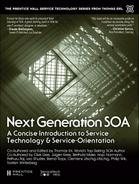Book Description
The Concise Introduction to Modern SOA: High-Value Approaches, Innovative Technologies, Proven Use Cases
After a decade of innovation in technology and practice, SOA is now a mainstream computing discipline, capable of transforming IT enterprises and optimizing business automation. In Next Generation SOA, top-selling SOA author Thomas Erl and a team of experts present a plain-English tour of SOA, service-orientation, and the key service technologies being used to build sophisticated contemporary service-oriented solutions.
The starting point for today’s IT professionals, this concise guide distills the increasingly growing and diverse field of service-oriented architecture and the real-world practice of building powerful service-driven systems. Accessible and jargon-free, this book intentionally avoids technical details to provide easy-to-understand, introductory coverage of the following topics:
Services, service-orientation, and service-oriented computing: what they are and how they have evolved
How SOA and service-orientation change businesses and transform IT culture, priorities, and technology decisions
How services are defined and composed to solve a wide spectrum of business problems
Deep implications of the service-orientation paradigm--illuminated through an annotation of the classic SOA Manifesto
Traditional and contemporary service technologies and architectures
How clouds and virtualization support the scalability and reliability of services-based solutions
SOA-based industry models, from enterprise service to global trader
A detailed case study: how real enterprises bring together contemporary SOA practices, models, and technologies
Next Generation SOA will be indispensable to wide audiences of business decision makers and technologists--including architects, developers, managers, executives, strategists, consultants, and researchers.
Table of Contents
- About This eBook
- Title Page
- Copyright Page
- Praise for this Book
- Dedication Page
- Contents at a Glance
- Contents
- Acknowledgments
- Chapter 1. Introduction
- About This Book
- How This Book Is Organized
- Chapter 2: An Overview of SOA & Service-Orientation
- Chapter 3: A Look at How Services are Defined and Composed
- Chapter 4: An Exploration of Service-Orientation with the SOA Manifesto
- Chapter 5: An Overview of Service Technology
- Chapter 6: A Look at Service-Driven Industry Models
- Chapter 7: A Case Study
- Appendix A: Additional Reading for Applying Service-Orientation
- Appendix B: Additional Reading for Planning for & Governing Service-Orientation
- Appendix C: Additional Reading for Cloud Computing
- Additional Information
- Service Technology Specifications (www.servicetechspecs.com)
- The Service Technology Magazine (www.servicetechmag.com)
- Service-Orientation (www.serviceorientation.com)
- What Is REST? (www.whatisrest.com)
- What Is Cloud? (www.whatiscloud.com)
- SOA and Cloud Computing Design Patterns (www.soapatterns.org, www.cloudpatterns.org)
- SOA Certified Professional (SOACP) (www.soaschool.com)
- Cloud Certified Professional (CCP) (www.cloudschool.com)
- Big Data Science Certified Professional (BDSCP) (www.bigdatascienceschool.com)
- Notification Service
- Chapter 2. An Overview of SOA & Service-Orientation
- Chapter 3. A Look at How Services are Defined and Composed
- Chapter 4. An Exploration of Service-Orientation with the SOA Manifesto
- Chapter 5. An Overview of Service Technology
- Web-Based Services
- Components
- Service Virtualization
- Cloud Computing
- API Management
- Model-Driven Software Design
- Semantic Web
- Business Process Management
- Composition and Orchestration
- Master Data Management
- Business Rule Engines
- Social Network Technologies
- Mobile Computing
- Agent-Driven Architecture
- Event-Driven Architecture and Complex Event Processing
- Business Intelligence
- Enterprise Information Integration and Extract-Transform-Load
- Big Data
- Chapter 6. A Look at Service-Driven Industry Models
- Chapter 7. A Case Study
- Systems Landscape
- New Marketing Strategy
- Corporate Culture
- Vehicle Maintenance
- The Billing System
- Strategic Considerations
- Cloud Adoption
- New Reference Architecture
- The Customer Profile Process
- New Service Technology
- The SOA Governance Program Office
- The Enterprise Architecture Board
- A Transformed Enterprise
- Appendices
- Appendix A. Additional Reading for Applying Service-Orientation
- Appendix B. Additional Reading for Planning & Governing Service-Orientation
- Appendix C. Additional Reading for Cloud Computing
- About the Authors
- Index
